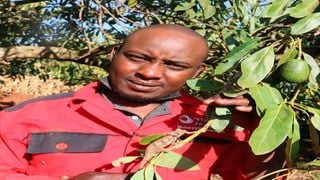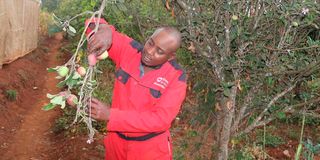
Charles Mburu at his farm in Kiambu County.
| Sammy Waweru | Nation Media GroupSeeds of Gold
Premium
I use chameleons to fight insect pests
What you need to know:
- The farmer has a permit from the Kenya Wildlife Service (KWS) to use the animals for pest control.
- Since the chameleons camouflage naturally, he does not worry about predators.
On his two-and-half acres in Ndeiya, Kiambu County, Charles Mburu grows a variety of fruits including avocados (Fuerte and Hass), tissue culture bananas, oranges, pawpaws, guavas as well as tree tomatoes.
Others are pepino melon, gooseberries, passion fruits, strawberry, apples, lemon, grapes, mangoes, custard apple, pomegranate and sugarcane.
“We have been growing fruits as a family for years. My grandfather grew fruits, my father took over now it is my turn to continue the legacy,” says Mburu, who holds a diploma in computer engineering.
While their main fruits have been avocados, oranges and pawpaws, Mburu has introduced the rest.
“We have over 20 varieties and we now grow them organically through use of compost manure and organic pesticides and pest control methods. I make my own pesticides from indigenous trees, pepper and crops like Mexican marigold,” he explains, adding that at the edge of every crop’s portion, he has pest repellent plants such as onions.
However, the most interesting bit of his organic fruit farming venture is the use of chameleons to curb insect pests.
“I have over 100 chameleons which feast on fruit pests. I deploy them during the onset of flowering period to curb pests such as green and brown lacewing. The pests are destructive at that stage.”
The farmer has a permit from the Kenya Wildlife Service (KWS) to use the animals for pest control. The licence, he says, he acquired it at Sh4,500.

Charles Mburu at his farm in Kiambu County.
Other destructive pests the reptiles eliminate are thrips, scales, mealybugs, whiteflies, aphids, fruit flies, false codling moths, leaf-miners, lady beetles and dusty wings.
“I have achieved a success rate of over 65 per cent with chameleons to eliminate pests particularly during flowering and fruiting stages,” says Mburu, who collects the insects from farms, forests, by the road sides and hedges.
When the crops are not flowering, he keeps the chameleons busy by moving them to cover crops that include Boma Rhodes and napier grasses.
According to him, they breed faster during the dry period and he keeps an eye on them to ensure they don’t cross to the neighboring farms.
Since the chameleons are camouflaging by nature to protect themselves, he does not worry about predators.
Generally, he says all chameleons are poisonous. “But they are cowards. Whenever they see a human being or animal, they hide or camouflage. The good thing is that they don’t feed on fruits.
Between January and February low season, Mburu harvests about 5, 000 pieces of Hass avocados. And during the high season that runs until July, production rises to 20,000 with prices ranging between Sh8 and Sh10 per piece.

Charles Mburu at his farm in Kiambu County.
From Fuertes, he gets between 2,000 and 5, 000 fruits during the low seasin and 5, 000 to 10,000 in the high season. He sells them at between Sh5 and Sh8.
He sells the fruits to East African Growers Ltd, who come for the yields on the farm. Demand is increasing, he says.
Other fruits that he is currently harvesting are pawpaws, cherry guavas, tree tomatoes, pepino melons and gooseberries.
The main disadvantage of using the reptiles to fight pests is that those who fear them wil not buy the fruits, says Mburu, adding his aim is to farm exclusively organic.
For the pests that chameleons cannot eliminate, Mburu uses the organic pesticides like charcoal dust and ashes and pig droppings to eliminate moles. However, his journey in farming has not been easy. Before turning to fruits, he also kept rabbits in which he invested Sh48,000.
“The supply was way too high than the demand. Out of 200 rabbits I kept, I only sold 20. I had to eat, give away and slaughter the rest for my dogs,” says Mburu, who also kept poultry, but later quit to concentrated on fruits.
Damaris Kagendo, a research scientist at Kenya Agricultural Livestock and Research Organisation (Kalro- Katumani), says the use of predators is effective where the pest population is low and that of chameleons high.
“They naturally prey on insects and having them on the farm means they keep hunting down insect pests. Nevertheless, they may not be effective in managing pests like the minute thrips, aphids and scales,” says the expert.





